If you do not have the opportunity to fold a classic brick oven or do not want to work as a stoker all winter, you should consider installing a boiler. long burning solid fuel. In general, solid fuel boilers run on any type of fuel - from coal and firewood to household waste. This is their main and indisputable advantage. And the biggest disadvantages include the fact that the fuel must be tossed up regularly. Although there are models that, subject to certain requirements, require laying firewood once every 12-30 hours, and coal, generally every few days.
The device of a long-burning (pyrolysis) boiler is distinguished by the fact that it has not one combustion chamber, but two: in the first one burns directly firewood, and in the second the gases formed in this case burn out. Thus, a much more complete combustion of the fuel is achieved, more heat is released, and soot, when using dry fuel, is practically not formed.
In long-burning boilers, the principle of "top combustion" is sometimes used, that is, not the entire volume of fuel burns at the same time, but only its upper layer of approximately 15 centimeters. For this, a special system for supplying air directly to the combustion zone has been developed.
Today on the market of heating equipment there are so many models of boilers and companies that produce them that it will not take long to get confused. Let's take a look at the products of some of them.
Boilers Stropuva
Many have heard about Lithuanian solid fuel boilers for long burning by Stropuva. Due to some design features, these boilers are also called gas-fired boilers. The basic design of this is 2 cylinders inserted one into the other. The space between them is filled with a coolant, and a layer of thermal insulation is applied outside. The smaller cylinder is the actual firebox, and the larger is the outer casing.
The firebox consists of two chambers, which are separated from each other by an air injection zone. The lower chamber is the firebox itself, in which combustion takes place according to the "top-down" principle. The upper zone is used to warm up the air to support the process. As the top layer burns out, the air distributor goes down. A telescopic pipe is welded to it, through which heated air enters the combustion zone.
The air is heated so as not to bring down the temperature in the firebox. For this, a special chamber is arranged, into which it enters through the air damper. This chamber is heated by combustion gases. The smoke heats up the air supply chamber before entering the chimney. This is another original solution that allows you to fully use all the heat.
The required temperature of the air supplied to the furnace is maintained by means of a draft regulator. The same regulator changes its quantity. This design allows to improve heat removal, to automatically regulate the degree of heating of the coolant and maximizes the boiler efficiency (up to 90%).
Now on the market of heating devices, you can find 3 options for long-burning boilers from Stropuva: wood-fired, and universal (multi-fuel), operating on any type of fuel.
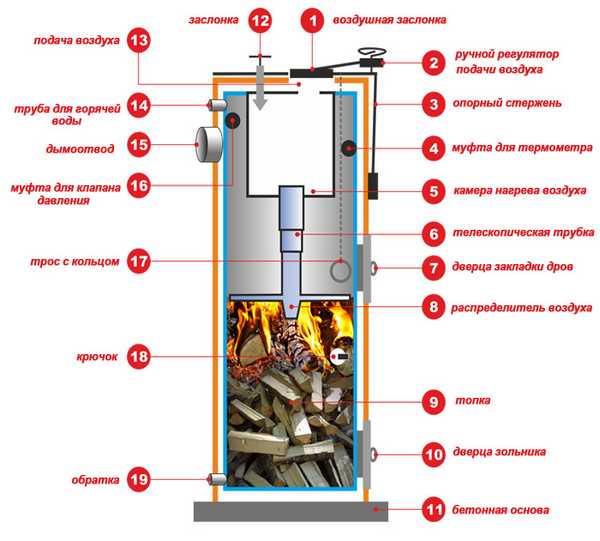
Long burning boiler "Stropuva" internal structure
Studying the reviews about Stropuva long-burning boilers, you can see that in practice everything turns out to be not as "rosy" as the manufacturers promise. One of the main disadvantages of "Stropuva" boilers is that consumers call a rather complicated piping of the boiler, which not everyone can do on their own. Manufacturers themselves in this matter strongly advise contacting specialists trained in the campaign. The quality of the boiler depends on the correct piping. In addition, like any long-burning boiler, it is quite "capricious" to the quality of the fuel. To obtain a sufficient temperature, the moisture content of the wood should not be more than 20%. Consumers using firewood with a higher moisture content note the following Negative consequences:
- the boiler cannot be “overclocked” above 50˚C;
- during operation, the chimney hums very strongly, "like an airplane taking off";
- burnout of the deflector;
- adhesion of a significant amount of soot in the chimney;
- when using wood species rich in essential resins (conifers) or tar (birch), an unpleasant odor may be observed;
- education increased number condensate.
If providing firewood with a sufficient degree of dryness is problematic for you, then it is better to use a universal boiler that can work on anything.
At the same time, Stropuva long-burning boilers, according to consumers, have at least one indisputable advantage - the burning time. Of course, it is quite difficult to achieve the indicators stated in the passport: on wood for up to 30 hours, and on coal for up to 5 days - but even without that, this boiler can be safely called the leader in terms of the burning time of one bookmark. If you are not ready to spend a lot of time at the boiler, this is what you need, while you should definitely invite a specialist to install it and set it up correctly.
Lithuanian Candle
The same device (and the country of the manufacturer) is also available for long-burning solid fuel boilers Sandle. Manufacturers declare that the minimum burning time for a firewood bookmark is 7 hours, the maximum is 34 hours. These boilers, unlike the omnivorous "Stropuva", are designed exclusively for firewood.
Studying the reviews on the use of this heater, it can be noted that sometimes when the temperature is set, smoke can seep into the room, there are complaints about the burnout of the air supply nozzle (because of this, a spare is provided in the configuration), the doors for loading firewood and cleaning ash are not very convenient ( small). And the price bites again.
German quality from "Buderus"
The German company Buderus (Buderus) is also quite famous in the heating equipment market. The range of products manufactured by this company is quite diverse. Their design is fundamentally different from the previous type of boilers. These are the so-called long-burning gas-generating boilers with a lower afterburning chamber. This means that the fuel is loaded into the upper chamber (furnace), and the smoke and gases formed during the combustion process are forced downward, where they burn out with the release of additional heat.
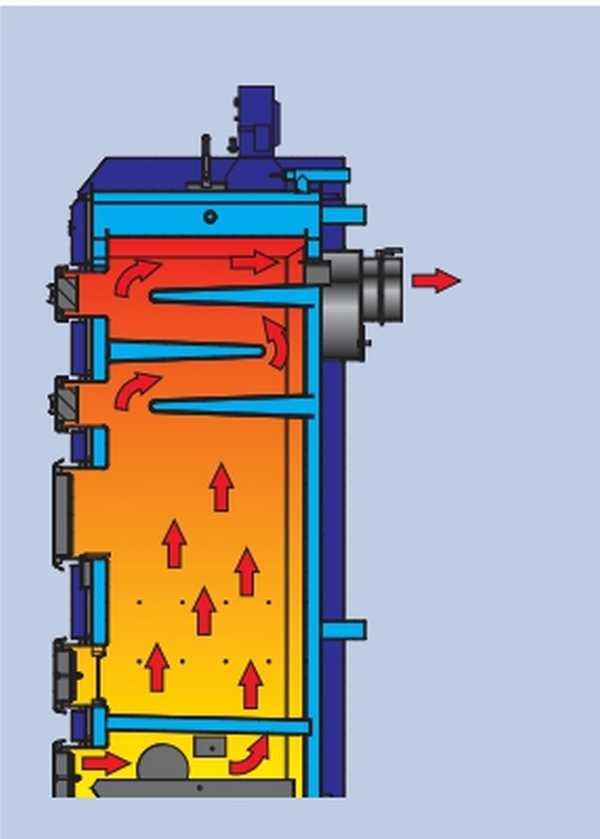
German long-burning boiler "Buderus" Elektromet modification
In the line of Buderus Elektromet boilers there is another design feature - the grates are made of pipes through which the coolant passes. This solution allows not only to make full use of the generated heat, but also eliminates the problem of grate burnout. For these boilers, the main type of fuel is coal, it can be fired or with untreated wood.
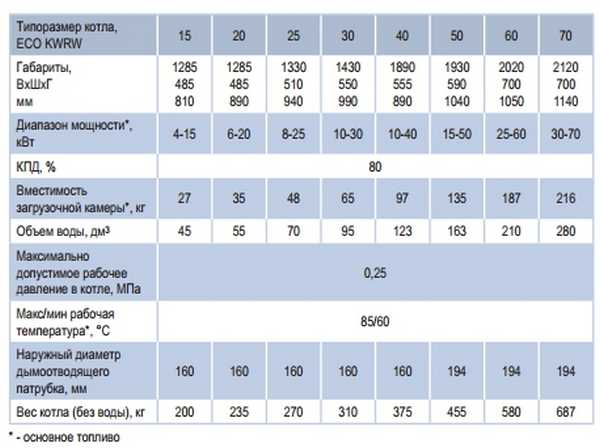
Technical characteristics of the long-burning boiler Buderus-Elektromet
The second line of German boilers - Logano - mainly uses firewood, therefore they have a larger loading door. The upper fuel chamber is also large. This model can use coal and coke. Logano can work independently or in tandem with gas or.
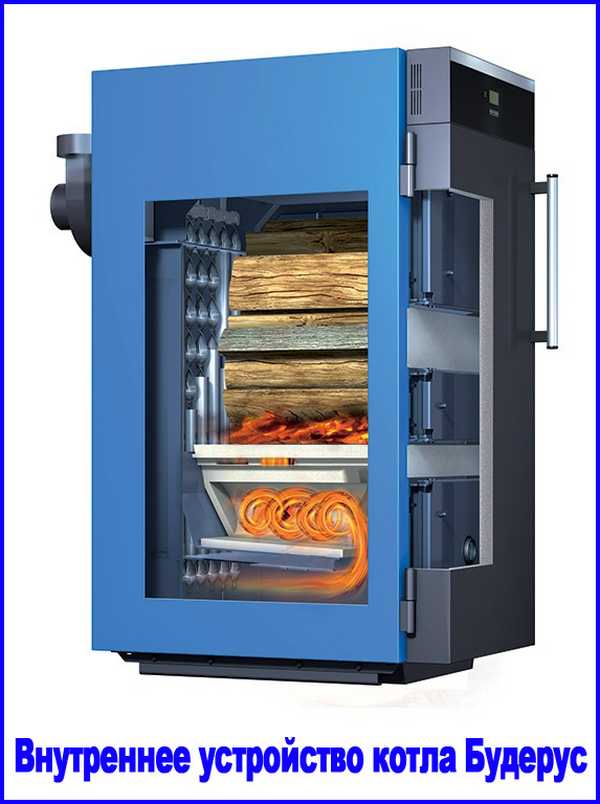
Internal structure of Buderus boilers
Another model of "Buderus" - Logika (Logic) - universal steel boilers that can be fired with wood, brown coal and coal, coal dust. Depending on the fuel, either the principle of upper combustion or lower combustion is used. This system allows you to achieve the best performance with any fuel and minimize emissions into the atmosphere.

Buderus_Logica - versatile boilers that can burn any fuel
According to consumer reviews, Buderus long-burning boilers have many advantages:
- they are very easy to operate;
- the installation is not too complicated and does not require any special knowledge and skills;
- small size.
All maintenance boils down to loading the firebox and cleaning the ash pan about once or twice a month, the rest will be done by automatic equipment. Almost all those who have been using this boiler for more than one year note its efficiency. Almost the only drawback that consumers blame is the rather high price. But "real German quality" cannot be cheap, can it?
Omnivorous Wichlach
The long-burning boiler "Vihlach" is another unit worthy of the closest consideration. These long-burning boilers are produced by Poland, or rather, by a Polish-Ukrainian joint venture. Wichlach boilers are made of steel with a thickness of 5-12 mm, without soldering, without external slots and slots. The dimensions of the firebox are quite impressive and, as the manufacturers promise, one tab should be enough for 48 hours of operation.
Long-term operation is based on the principle of upper combustion of fuel, for which air is supplied directly to the combustion zone. A special point feeding system has been developed, which improves combustion in problem areas: along the edges of the firebox.
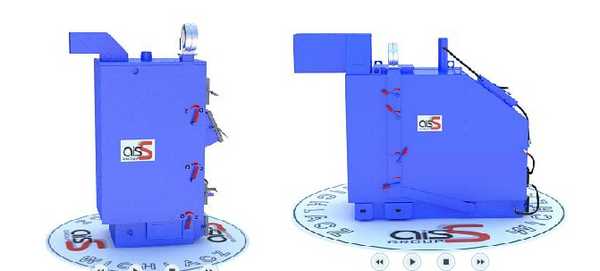
Long burning boiler of Ukrainian-Polish production "Vihlach"
Another design feature is water grates, that is, these are not just pieces of fittings, but pipes through which the coolant flows from the system, so that ash and soot do not burn to the metal. The flowing heating medium cools the steel, which makes the grates last longer. All pipes are coated with molybdenum, which almost completely eliminates the formation of rust.
Vihlach melts quickly: it reaches operating temperatures in 20 minutes. There is a possibility of smooth manual or automatic adjustment. Moreover, you can regulate the temperature of the coolant and the air in the room. But to adjust the atmosphere in the room, you need to install a temperature sensor. And the main pleasant feature of this boiler: it burns almost any fuel, any moisture: firewood, sawdust, peat, coal - hard and brown, coal waste - litter and dust, various and solid household waste. If you need a boiler that is not capricious in relation to fuel - your choice is Wichlach.
It is quite difficult to find negative reviews about boilers of this brand. According to customer reviews, they are economical, burn for a long time, and are undemanding in service. One of its indisputable advantages is that you will never have garbage at home or at work: everything goes to the furnace. The price is also pleasing - much less than that of foreign counterparts.
"Buran" burns wet fuel
Long-burning boiler "Buran" of Ukrainian production. Its design is very similar to the Lithuanian "Stropuva", but much less demanding on the quality of the raw material burned. There are also some peculiarities.
The air distributor in these boilers can rotate around its axis, which makes it possible to clean the fuel chamber from carbon deposits and ash without any problems. It is designed in such a way that it makes the air in the firebox move clockwise. This allows you to increase the combustion area of the fuel: it burns over the entire area, and not only in the center.
For efficient combustion of raw fuel (wood may have 50% moisture content), the boiler is equipped with a fan and an electric temperature controller. The doors have a special design: they can be adjusted to prevent air leaks during firing up and prevent smoke from leaking into the room. Several movements change the density of their adherence to the body.
In general, the developers took into account most of the shortcomings of boilers already existing on the market, and received a very decent and high-quality version of the upper combustion furnace. "Buran" has two lines - one wood-burning (use firewood, briquettes, wood waste) and universal (all the same types of fuel, plus coal).

At the price, "Buran" is quite affordable, the burning time is quite decent. According to the factory data, a wood-fired boiler operates on one load up to 30 hours, on peat briquettes - up to 50 hours. Universal "Buran U" may not extinguish on coal for up to 5 days.
Unfortunately, there are very few reviews about Buran boilers, but, remarkably, not a single negative one. The unit works quietly and long enough, economical, although it still does not always reach the stated operating hours. A small drawback can be considered the fact that if you purchased a coal-fired boiler, then it is better to use larger fractions, since the fine fractions can sinter and not completely burn out. Although they found a way out of this situation: the caked pieces can be reused. Due to the fact that the combustion chamber has a ribbed surface, it should be additionally cleaned a couple of times during the heating season with a metal brush.
Boiler "Prometheus"
The long-burning boiler of the "Prometey" company is presented on the domestic market of heating devices in three variations:
- "Prometheus" - a classic solid fuel boiler;
- Coal-fired boiler with pyrolysis mode of KVDG operation
- "Prometheus-Kombi" - combined hot water;
- "Prometheus - Eco" - gas generator version;
One of the features of the classic Prometheus boiler is the grate arrangement. They are made up of individual cast iron elements. This allows you to replace the burned-out parts of the structure, and not the entire grate as a whole. There is also a handle for "shaking" the grates, which makes it possible to clean them during operation.

The long-burning boiler "Prometheus" is equipped with a suction fan. Therefore, even with an open bunker for storing fuel, smoke will not enter the room. There is also a turbulator that cleans the surface of the heat exchanger directly during combustion.
The equipment is undemanding in operation and is produced in two modifications: it can be controlled in manual mode and in automatic mode (using the control panel).
For lovers of comparisons of technology, it can be noted that, according to consumer reviews, the long-burning boiler "Prometheus" is almost a complete analogue of the German "Buderus" (the only difference is in the design of the grates). However, according to consumers' estimates, these are boilers of rather average, "budgetary" quality, although they have excellent automatic protection (Italian design).
Practice has shown that "Prometheus" require more frequent cleaning compared to other brands (about one and a half times a week), otherwise an unpleasant smell is felt. In fairness, it is worth noting that boilers from other manufacturers quite often sin with this drawback. In favor of this brand, we can say that "Prometheus" is much cheaper than "Buderus". However, some customers complain about not very high-quality assembly and a rather inconvenient ash pan (you can get smeared when removing ash). In general, if you are "lucky" with the assembly, then "Prometheus" is a good "low-budget" option.
If you want to spend as little time at the boiler as possible, then you definitely need to get a long burning time. The principle of its operation lies in the fact that a large amount of wood pellets is loaded into a special one. They are fed into the furnace in portions using a special auger. This is very convenient, since your job is to periodically check the amount of pellets in the booker.
But, before installing such a boiler, you should inquire about the cost of pellet granules and the possibility of delivery in your region. This equipment does not operate on any other type of fuel. Another drawback is their exactingness to the quality of raw materials and their high cost. But it pays off with the efficiency of heating.
In general, think, count, choose, weigh all the pros and cons, because a properly selected boiler will long years please you with my warmth.
The concepts of coziness and comfort in the house are inextricably linked with warmth. Therefore, first of all, modern housing should have a high-quality heating system. Its main component is a heating boiler, which heats the coolant to a predetermined temperature. Such units can be of different types, operating on different fuels and having a different operating principle from each other. Solid fuel boilers are among the most demanded on the market.
How a solid fuel boiler works

To understand how boilers work on solid fuel, you need to know how they are arranged. These constructions consist of the following components:
- Combustion chamber... It is here that the fuel is loaded, which, when burned, releases the necessary heat. This camera is equipped with a special door.
- Grate... It is on it that the fuel is laid when loading. When it burns out, the ash falls into the ash pan located below.
- Cleanout hatch, which is used to clean the boiler from combustion products.
- Heat exchanger, through which the coolant is heated. This component is made in the form of a large container through which the smoke tubes pass. The gases released during fuel combustion circulate through the pipes of the system, due to which the coolant is heated in the heat exchanger.
- Thermostat, by means of which the speed of fuel burning is determined.
Important! The above elements are considered basic in such structures. However, in addition to them, such equipment may include additional components, greatly facilitating the operation of the system. These include gas burners, draft regulators, thermostatic valves, etc.
The draft regulator is a very important component through which the temperature inside the supply pipe is regulated. Thanks to him, the air is controlled in the combustion chamber. Under heating, this equipment expands, as a result of which it acts on the damper, slightly opening it.
Important! The operation of boilers with a draft regulator can be carried out automatically, without human control. The regulator is a small-sized device placed on the front wall of the boiler. When the boiler starts up, the regulator ensures that the operating temperature is kept within the range of 65-90 degrees Celsius.

The gas burner can operate on liquefied or natural gas. Its presence in the system provides several important advantages:
- The ignition process does not exceed a few seconds.
- Simplicity of design, due to which the equipment receives the necessary reliability.
- High level of security.
- Possibility of using in boilers of various types.
- Operation in closed rooms.
The thermostatic valve ensures quick heat dissipation in case of boiler overheating. In this case, in order to cool the apparatus, the heated coolant is drained from the system, the place of which is filled with cold water.
Important! In devices with a cast-iron housing, the cooling circuit is located on the supply, and in steel analogs - inside the housing.
How does a solid fuel boiler work

Solid fuel boilers except wood can be used in their work different types fuel. It can be pellets, peat, coal, etc. The cycle of a boiler of classical design includes three phases:
- Ignition... The operation of the equipment begins with ignition. On this stage there is a sharp increase in temperature in the chamber (up to 600 degrees Celsius). The temperature also rises in the combustion exchanger, reaching a value of 40-70 degrees. In this case, a lot is determined by the parameters of the system.
Important! At a minimum, thermal shock can occur, which can have negative consequences for both the heat exchanger and the system. Cast iron heat exchangers are able to withstand such loads for a long period, but over time they simply burst. With rapid warming up against the background of a low speed of liquid circulation, the liquid may boil, as a result of which the heating system experiences a water hammer. Plastic pipes are the most vulnerable to this phenomenon. On initial stage the operation of the equipment, the following occurs: the air in the room remains cold, but the pipes are already sufficiently warmed up. Therefore, the correct calculation of all indicators is very important.
- The second stage is characterized by heating of the coolant... As the temperature rises, the temperature in the furnace reaches 1000-1300 degrees. At this stage, it is very important to control the heating of the coolant, which can heat up to 95 degrees, which is dangerous for the system. The degree of heating can be regulated by means of a special valve that supplies air to the system.

Advice! It is necessary to control the temperature of the coolant until the fuel is completely burned out. This phase is characterized by heating pipes and heating the air in the room.
- At the third stage, the fuel burns out... When the fuel is completely burned out at the end of the cycle, embers are formed. Against this background, the temperature in the system also decreases, reaching 400-500 degrees. And it is precisely this temperature regime that is most comfortable for the system. A slow cooling of the coolant is observed, during which the air in the room also cools.
Important! When embers are formed, the process of cooling both the coolant and the air in the room is accelerated.
Based on the results of the work cycles discussed above, it can be concluded that solid fuel heating boilers are characterized by one feature - temperature cyclicity. And in order to minimize the temperature spread as much as possible, it is necessary to periodically put a new portion of fuel into the system.
The solution to this problem was implemented in automatic boilers. In such designs, the fuel supply and the blowing of the burner fan are carried out automatically. Conventional design options require constant monitoring.

Gas boilers represent the most profitable solution for heating a private house. Such equipment has a fairly large number of characteristics, the main of which is the type of performance. Boilers are floor-standing and wall-mounted. And for many people, choosing one of these options is a daunting task. Therefore, to make the right decision, it is necessary to consider the main characteristics and differences between floor and wall units.
Principles of operation used in solid fuel boilers
There are several options for solid fuel boilers. The differences in this case lie in the principle of fuel combustion, from which in no small degree the operating time also depends on one load.
Classic models
Such equipment is equipped with a large furnace, where fuel combustion occurs naturally. Such designs provide for the use of a special sensor that monitors the temperature of the coolant.
Important! Classical boilers are characterized by a very simple design, which greatly simplifies their operation and reduces costs. Such units are undemanding to fuel and can operate on wood, coal, briquettes and other similar raw materials.
These designs have some disadvantages:
- Low efficiency in comparison with long-burning boilers.
- Short burning time: no more than eight hours of operation on one tab.
- Due to the non-optimal combustion process, an increased ash content appears.
- Heating modes are difficult to automate.
Advice! Of the above disadvantages, only one can be eliminated. The problem with frequent loading can be partially solved by installing a special tank, which can reduce the likelihood of temperature changes due to the accumulation of heat. Such a container is all-metal and must have good thermal insulation characteristics. The calculation of the volume of such a tank is carried out depending on the heating system, as well as the capacity of the equipment.
Long burning constructions
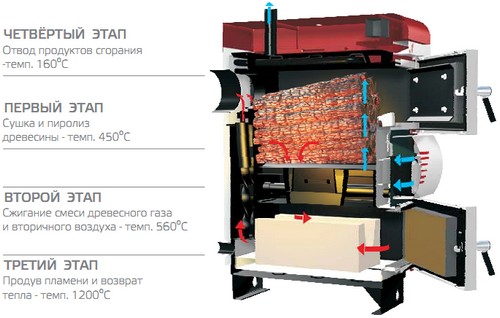
Long burning units do not have the disadvantages of their conventional counterparts. They are of two types:
- There are two combustion chambers in the design of pyrolysis boilers... The peculiarity of their work is that fuel combustion is carried out under conditions of insufficient oxygen. The temperature in the chamber rises, causing the release of wood gas. This process is called pyrolysis. Further, the gas enters the second chamber, where it is burned with an excess of oxygen. Thanks to this feature, the system ultimately has a very high efficiency, reaching up to 90%.
- Smoldering units... Such structures are equipped with a built-in water jacket, which is installed around the perimeter of the unit. In this case, the fuel does not burn from bottom to top, as usual, but from top to bottom, which, along with a large combustion chamber volume (up to 100 liters), ensures a long-term operation of the equipment.
Video: choosing a solid fuel heating boiler
A solid fuel combustion boiler of the pyrolysis type is capable of providing complete combustion of the fuel. In this case, ash removal from the system is carried out no more than once every two to three days. With a relatively low fuel consumption, such designs are able to operate on a single load for about 12 hours.
Also, the advantages of such units include:
- The ability to maintain the required coolant temperature for a long time.
- The combustion control system can be automated.
- Heating a house with a solid fuel boiler of this type may involve the use of other types of solid fuels along with firewood.
Important! The disadvantages of pyrolysis boilers are the high cost of such equipment and the requirements for the permissible moisture content of the raw materials used. It should also be remembered that such settings are volatile, and therefore may not be used in all situations.
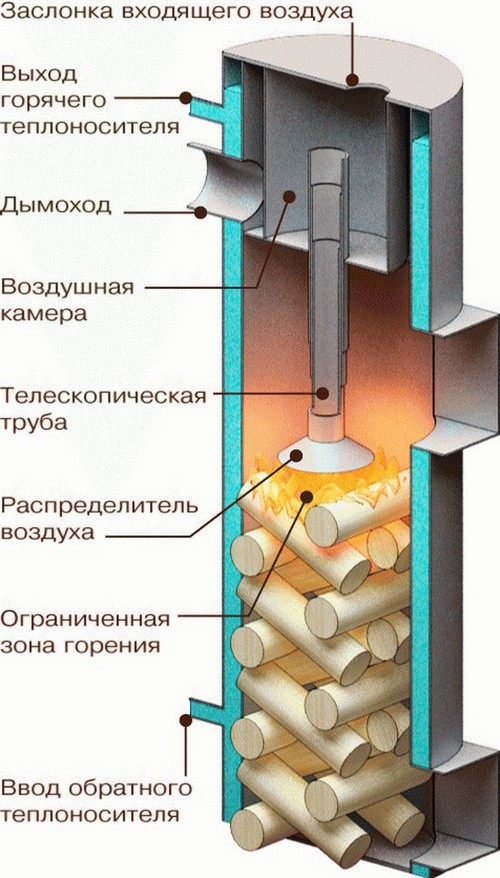
The glow type models also have their advantages:
- Depending on the model, such structures can operate for up to 5 days on one tab. Naturally, in this case, the duration of work depends on the type and quality of fuel. Coal burns the longest.
- Compared to pyrolysis boilers, such boilers are less expensive.
Among the disadvantages should be highlighted the high demands on fuel. Only wood with a moisture content of up to 20% can be used in boilers of a smoldering type. Also, fuels containing a large amount of tar are not allowed to be used. If it is still used, then the system will have to be cleaned much more often, which leads to a decrease in the service life of the automation.
The best boiler manufacturers
Today, boilers for heating a private house are manufactured by a number of companies. To purchase a really high-quality option, you need to pay attention not only to the technical characteristics of the selected unit, but also to the brand. The most popular are the following manufacturers:
- Buderus... German company specializing in the production of high quality heating equipment. It is one of the leaders in the European market.

Solid fuel boilers Buderus - high quality and economy
- Wisman... An Italian company formed in 1917. Today, the manufacturer is a real veteran of the heating equipment market, with 22 factories located around the world. Every year the company introduces new technologies into the production of its products, which allows it to create the highest quality heating units at relatively low prices.
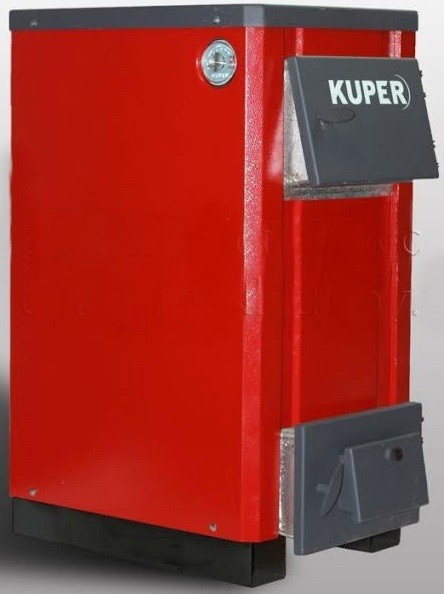
- Lemax... The company producing solid fuel boilers equipped with steel heat exchangers is located in Taganrog. Boilers Russian production have proven themselves as reliable units. The company's products are different high quality at a competitive cost.
- Don Conord... Another Russian manufacturer whose products have gained significant popularity in the domestic market. The plant is located in Rostov-on-Don and is engaged in the production of high-quality heating equipment.
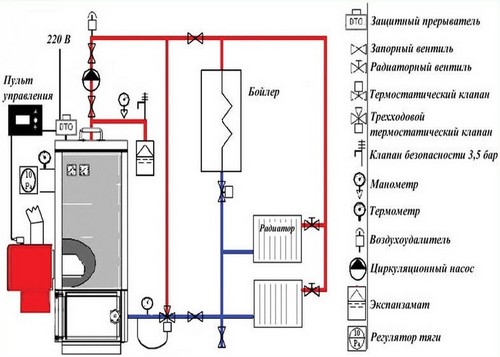
Conclusion
Solid fuel boilers are the most popular heating equipment for private use. They are produced in various designs, on which the technical characteristics of these units directly depend. Therefore, in the choice, you should take into account a number of important nuances described above.
Is it worth changing liquid fuel or electric boilers to solid fuel boilers? Will home heating costs decrease? What are they - solid fuel heating boilers?
Let's figure it out.
Selecting a heat source
Expenses
First, let's find out how cheap it is. heating boilers on solid fuels in comparison with other sources of thermal energy. Fortunately, information on the cost of a kilowatt-hour of thermal energy received different ways, it's easy to find.
An important point: information is often presented somewhat biased.
For example, manufacturers of heat pumps willingly cite statistics according to which it is their heating method that is the cheapest.
It is clear that on the websites of sellers of gas equipment you will find a completely different alignment of prices.
Let's take data from an independent source.
They may not accurately reflect the current situation in individual regions; however, the approximate ratio will remain.
- A kilowatt-hour of heat generated by burning main natural gas will cost about 0.52 rubles.
- the production of a kilowatt-hour of heat will consume exactly one kilowatt-hour of electricity, which on average in Russia now costs about 3 rubles. If a heat pump of any type is used instead of direct heating, the price of heat will decrease by about 3–3.5 times.
- When diesel fuel burns, a kilowatt-hour of heat released will cost about 2.8 rubles.
- A solid fuel heating boiler when burning firewood will provide us with costs at the level of 0.8 r / kW * h.
- A solid fuel coal heating boiler will increase costs up to 1.2 r / kW * h.

The conclusions are clear.
- Gas is the leader in terms of cheapness. If a gas main is connected to your home, the choice is obvious.
- The second place is shared by solid fuel heating boilers and.
- On the third, a solid fuel heating boiler fired with coal.
The convenience of use
Evaluation of equipment for cheap heating starts but does not end. An equally important factor is ease of use.
What criteria can be used to evaluate this parameter?
- The ability to work in a completely autonomous mode for a long time.
- The ability to maintain the set temperature in the room with high accuracy. We emphasize: it is in the room. The climate in the house is nonlinearly related to the temperature of the coolant: the weather outside affects it at least no less.
Any heat pump, regardless of the source of low-grade heat, is a fully automatic system and, as a rule, equipped with electronic thermostats already in the factory.
Gas boilers, as you know, are divided into non-volatile and equipped with electronic ignition. In the former, the simplest mechanical thermostat is implemented; the latter are capable of using remote sensors in any part of the heated house. Neither one nor the other requires frequent maintenance.
What in terms of convenience can boilers for solid fuel heating offer us?
- The protection of a solid fuel boiler from overheating of the coolant is, as a rule, the same simple mechanical thermostat, which, when a critical temperature is reached, closes the blower by means of a lever and a draft.
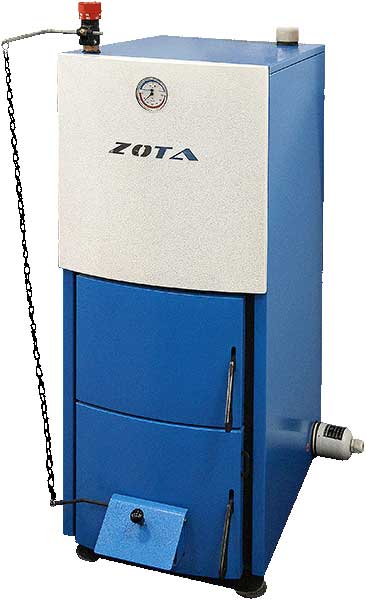
- Remote thermosensors can only be used by gas-generating boilers, which require forced pressurization to maintain two-stage fuel combustion. In this case, the fan speed is controlled by simple electronics.
- Finally, autonomy. With her ... let's say delicately, everything is bad.
The simplest low-power devices made with their own hands burn a supply of firewood in 1-3 hours; the absolute record holder for burning duration is the Lithuanian solid fuel boiler Stropuva, which, thanks to an unusual fuel combustion scheme, is able to work on one tab for up to one and a half days.
We will analyze the principle of operation of upper combustion boilers from Stropuv and other manufacturers in the corresponding section of the article.
However, as usual, the devil is in the details.
- Trunk natural gas is not available everywhere, and the use of bottled propane practically equalizes the cost of heating with an electric boiler.
- An air source heat pump works effectively only at winter temperatures around zero degrees Celsius. With a decrease in the outdoor temperature, the consumption of electricity for the production of a kilowatt of heat increases; at -25 and below, air heat pumps simply do not work.
- , operating on the "water-to-water" scheme, are more versatile, but in terms of purchase and installation costs are comparable to the cost of building a small house. For comparison: Russian steel boilers Karakan and Dobrokhot with a capacity of 12 kW cost about 14-16 thousand rubles, and a Ukrainian 14-kilowatt Cleaver can be bought for 2500 hryvnia (10,000 rubles at the current exchange rate).
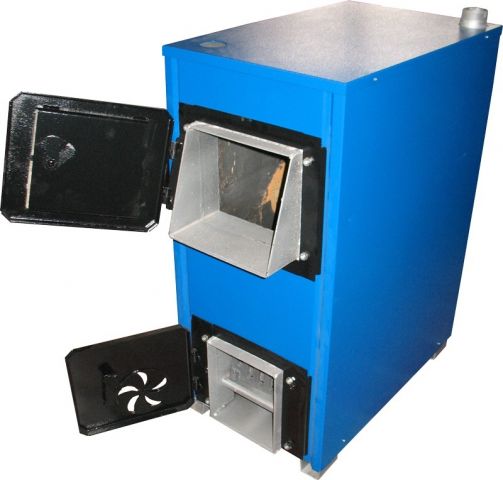
That is why, in practice, where the gas main is located at a considerable distance from the construction site, it is solid fuel heating installations that lead in popularity.
Boiler types
Let's try to figure out by what criteria devices can be classified.
Material
- Steel is strong and makes the walls of the boiler and heat exchanger relatively thin, and therefore cheap. However, the downside of low cost is limited durability. It is from steel that a huge number of homemade structures are made. Instructions and drawings, if desired, are online in a matter of minutes.
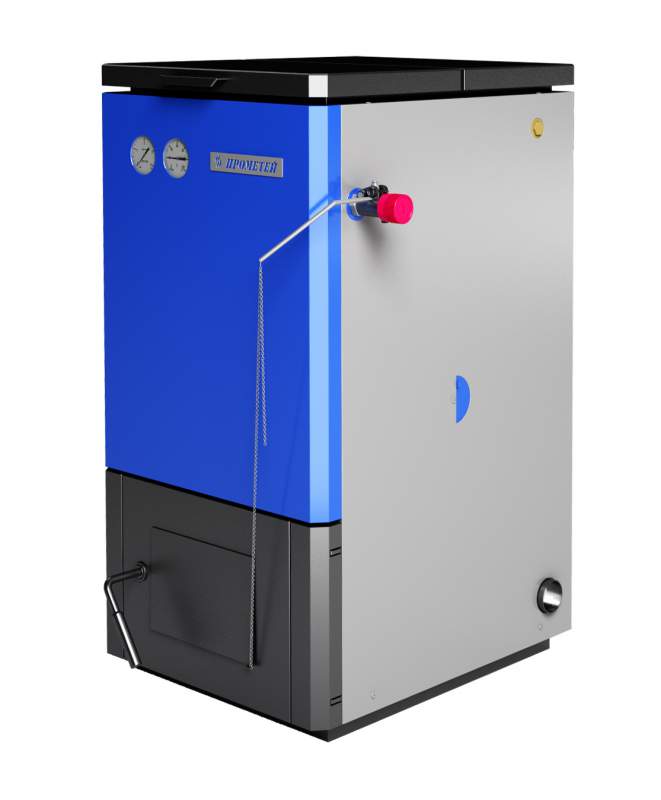
Useful: the service life of a steel firebox is significantly increased if it is lined with refractory bricks.
- Cast iron is more typical for massive devices with a power of 20 kW... Low mechanical strength (primarily in relation to shock loads) makes the walls of the boiler and the firebox thick enough; as a result, the weight of the boiler can reach 250-300 kilograms.
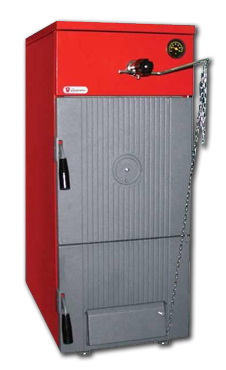
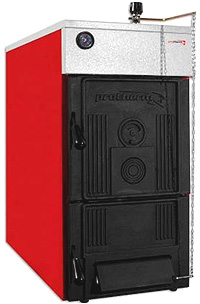
Type of fuel
- Wood-burning boilers are capable of working only and exclusively on wood with a moisture content of no more than 20%.
- Coal, respectively, are optimized for more high temperature combustion of coal.
- Pellets are intended for use of woodworking waste pressed into pellets. The advantage of devices of this type is in the automated feeding of fuel from the bunker, which makes it possible to make the loading rather rare; however, in practice, it is not possible to ensure an uninterrupted supply of pellets everywhere, and their cost is incomparable with coal or firewood.
- Versatile products can use different types of fuel. A variety of combinations of heat energy sources are possible: for example, a solar burner can be mounted in a separate firebox of a wood-burning boiler; a coal boiler can be supplemented with several heating elements in the heat exchanger tank, and so on.
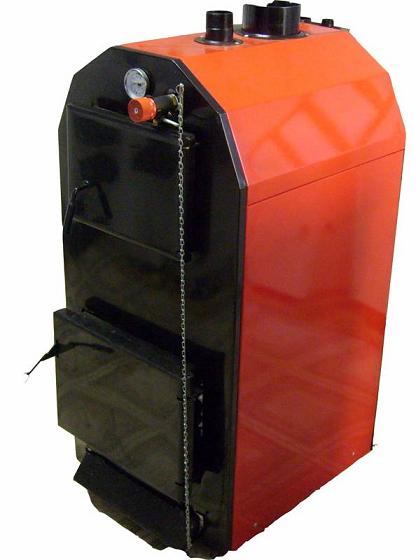
Yaik KSTGZH -16A after installing the burner in the firebox is able to switch from firewood to gas or diesel fuel.
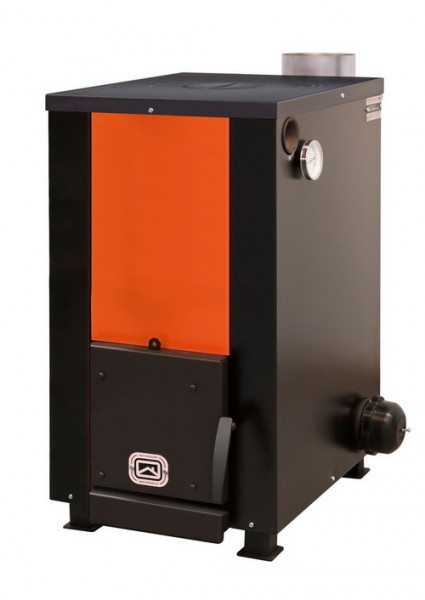
Traction type
- Natural thrust occurs due to the density difference between the hot combustion products and the ambient air. The advantage of the scheme is energy independence; the disadvantage has already been mentioned: only the most primitive control of the temperature of the coolant is possible.
An important point: limiting the air flow through the blower means, among other things, a drop in efficiency due to incomplete combustion of the fuel.
- The forced draft allows you to flexibly regulate the thermal power of the device using programmers and remote thermostats; however, in the absence of electricity, the boiler will be shut down by the automatics.
Taking into account the specifics of the Russian hinterland, where wire breaks and thefts are not uncommon, it is not easy to make an unambiguous choice in favor of such a solution.
Non-standard solutions
There are several designs that deserve special mention.
Pyrolysis (gas generating) boilers are distinguished by the fact that the combustion of fuel in them is divided into two phases. During the combustion of wood with limited access to oxygen, the so-called pyrolysis gas is formed, which is then burned out in a separate chamber.
What is the result?
- The efficiency increases. In the best boilers of this type, it reaches 92%; in addition, the efficiency does not fall when the thermal power is limited.
- There remains a minimum of solid waste.
- The regulation of the combustion process is made more flexible.
- Firewood is required every 10-12 hours.
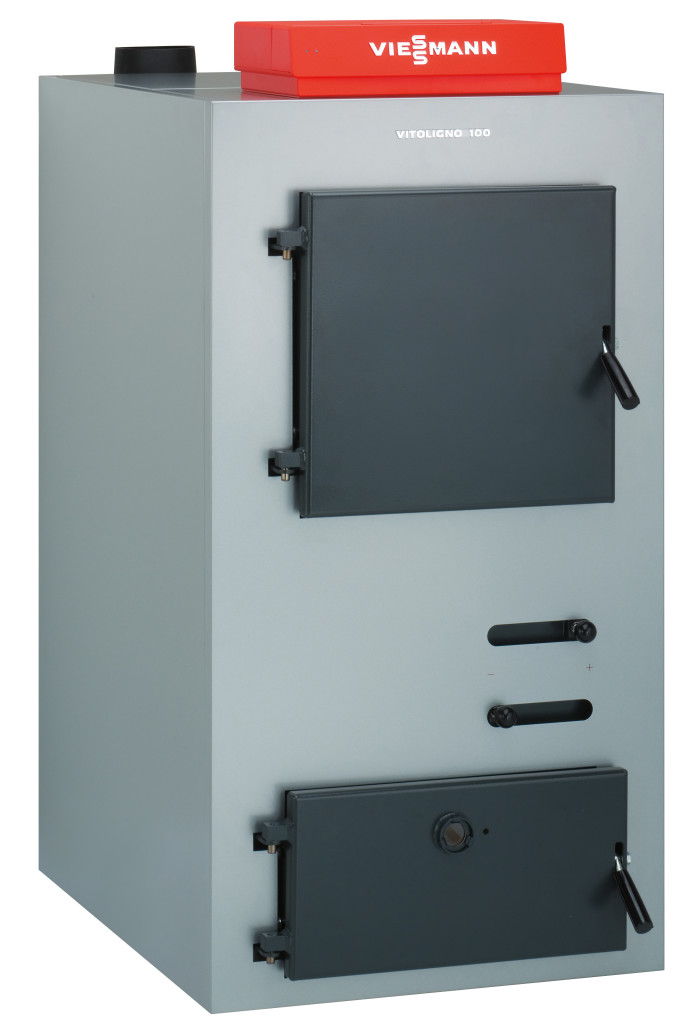
Top-burning boilers require loading every 20-30 hours. Combustion occurs only in the upper layer; firewood, coal or peat smolder with the release of pyrolysis gas, which burns out in the same firebox, but behind a massive metal separating disc. The ash is carried away by the ascending air stream.
![]()
Heating and cooking boilers are equipped, in addition to a built-in heat exchanger, with a hob above the firebox.
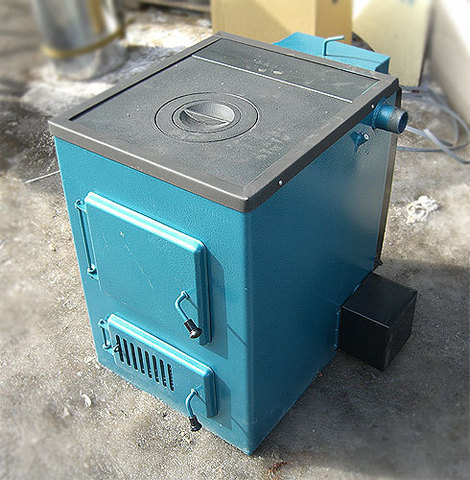
In the photo - Heating and cooking smoke AOTV-18.
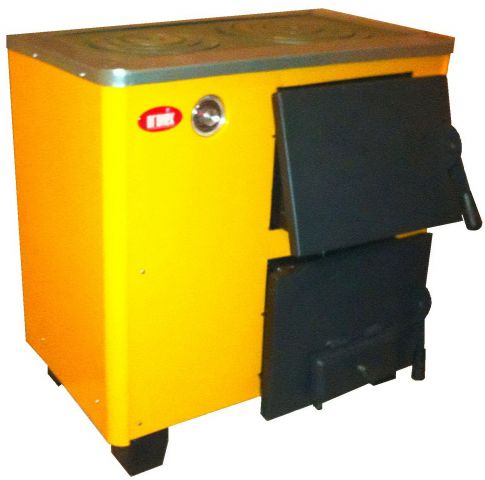
Output
Modern solid fuel heating boilers are quite a worthy and, most importantly, inexpensive alternative to electric and oil heating installations. As usual, in the video presented in this article, you will find additional information on this topic. Warm winters!
For many, a solid fuel boiler is the only option for heating a country house due to the lack of developed infrastructure and the impossibility of arranging a Russian stove. But a solid fuel boiler can also be used as a backup heating in tandem with oil, gas and electric boilers. A solid fuel boiler has a number of features, but considering them at the stage of choosing and installing a boiler, you can get comfortable, economical and safe heating with hot water supply. Below we will consider existing species solid fuel boilers and options for their rational use in various heating systems.
Classic and pyrolysis solid fuel boilers
In a classic solid fuel boiler, top combustion of fuel takes place. These boilers are widely used due to their simple design and due to the combustion of the entire volume of fuel.
In the pyrolysis (gas generating) boiler, the bottom combustion of fuel takes place, which is characterized by zonal combustion at the very bottom, due to which high efficiency and low emissions of harmful substances are achieved. The pyrolysis boiler operates on the principle of gasification or pyrolysis. The principle of pyrolysis is the release of combustible gas from fuel (wood) under high-temperature exposure, in the absence of oxygen, which then enters the combustion chamber.
Pyrolysis boilers
Boilers of this type are distinguished by a wide range of capacities, high efficiency, since they provide maximum combustion of fuel, lax requirements for the chimney due to the presence of a blower fan. However, such pleasure is much more expensive and requires a special approach. For example, not everyone knows that pyrolysis boilers are very sensitive to the temperature of the boiler water and the moisture content of firewood - to operate a pyrolysis boiler, you need fuel with a moisture content of no more than 20%, and this is firewood dried for 12 months. Obviously, not everyone is able to maintain a large supply of such fuel. Do not forget that careless sellers, dreaming to sell the boiler faster, often keep silent about its features.
Cast iron and steel boilers
Among solid fuel boilers, two main groups can also be distinguished - these are cast iron and steel boilers.
Let's start with the features of cast iron solid fuel boilers. Such boilers have little reaction to the quality (hardness) of water, but they are very susceptible to the temperature regime of the make-up water.
Pay special attention to the fact that from the supply of cold water for replenishment into the line of the hot heating system, the heat exchanger will collapse from the temperature drop. Therefore, it is necessary to feed the heating system of a cast iron boiler with warm water.
Another feature of cast iron heat exchangers is their massiveness, which significantly slows down the time of heat transfer to the room. At the same time, the efficiency of cast iron boilers decreases less even due to the formation of carbon deposits, which frees the owners from constant tedious cleaning of the heat exchanger. Thus, a consumer who plans to independently service the boiler can be advised the cast-iron option. It is resistant to corrosion, more durable and unpretentious. If the boilers need to be installed in a boiler room, where professional equipment maintenance is organized, then it is preferable to stay with a steel boiler, primarily because it provides the consumer with heat more efficiently.
Non-volatile and volatile boilers
Volatile - these are most often pyrolysis cast iron and steel boilers with an electric control panel and a built-in fan for air injection. Non-volatile, on the contrary, can work without power supply in heating systems with natural circulation. However, it should be noted that the performance characteristics of a natural circulation system are always inferior to forced circulation heating systems.
What, first of all, should be guided by when choosing a solid fuel boiler?
- What boiler power do you need. The power of the boiler depends on the materials of the walls and roof, the thermal insulation of the building, the required heating area and the temperature regime. We recommend that you contact a specialist to calculate the required boiler power.
- How often will you use the boiler. If the boiler is installed as the main source of heat, the most important indicators will be durability, reliability, efficiency, ergonomics of operation and the frequency of loading the heater. We recommend that the heating system be completed with an intermediate storage tank (buffer tank). It serves several functions:
- Protects the solid fuel boiler from overheating by mixing the overheated coolant with the warm one;
- Accumulates the coolant and gives it to the heating system as needed (automation is required);
- Reduces the frequency of fuel loading;
- Allows you to operate several heating devices (gas, liquid fuel, electric boiler).
- What kind of fuel will you heat the boiler with? Typically, the boiler capacity is indicated when using coke (highest calorific value), so this must be taken into account when using another type of fuel.
Advantages of solid fuel boilers:
- The prevalence and availability of fuel, environmental friendliness;
- Safety - with strict compliance with the recommendations for installation and operation;
- Ease of implementation of such heating (no developed infrastructure, design work, expertise, etc.).
Cons of solid fuel boilers:
From all of the above, the following conclusion can be drawn - it is possible to use a solid fuel boiler as the only source of heat only if all the features of its operation are taken into account. For example, the inconvenience of the need for frequent loading of fuel can be eliminated by installing a heat storage tank, an electric boiler or a backup heating element. This will protect the system from cooling in the event of a delay in fuel loading.
The installation of a membrane expansion tank and a circulation pump, which, in turn, needs an uninterrupted power supply, will help prevent the boiler from overheating in the event of a sudden power outage.
An additional way to regulate the boiler power can be provided by the secondary air hole on the side wall of the boiler.
The reliable operation of a modern solid fuel boiler is impossible without a suitable chimney, resistant to the action of acids, therefore it must be chosen with special care.
Very often, the reason for the ineffective and sometimes unsafe operation of the boiler lies in improper installation and operation. Obviously, such complex technical equipment as a boiler must be installed by specialists with the appropriate experience and qualifications. They probably should know that the project of the boiler room and chimney of a solid fuel boiler should be created taking into account individual characteristics and technical characteristics a specific boiler.
Information provided by the site http://www.argogas.ru
Conventional solid fuel boilers have one drawback. They require increased attention. It is necessary to put fuel on time, clean it, etc. These inconveniences can be overcome by long-burning solid fuel boilers designed for a long operating cycle. How is this convenience provided?
Installation of uninterrupted supply of bulk fuel
The principle is very simple. A bunker is connected to the boiler, into which, as a rule, wood pallets are loaded. The screw feed sends them to the furnace, where they are burned. Convenience lies in the fact that thanks to the impressive capacity of the bunker and automatic fuel supply, you can forget about the boiler for a while and calmly go about your business.
The Czech company Viadrus produces a range of solid fuel boilers equipped with bunkers.
Ekoret... It can work on wood pellets, brown coal and hard coal. Power, depending on the configuration, is reached from 4.5 to 25 kW. The combustion chamber is made of steel, protected by ceramic plates. Cast iron heat exchanger. Fuel supply, pump and fan operation are controlled by an automatic device connected to a temperature sensor. In case of overheating, protection is provided by a safety thermostat.
Hercules ECO... Long-burning solid fuel boilers of this model range have a capacity of 7 to 42 kW. They work on wood pellets. A distinctive feature is automatic ignition, the ability to work together with solar systems, equithermal regulation of boiler and heating water. Waste gases contain minimal amount emitted harmful substances, due to which this series has received the sign of the Eco-friendly product. The fuel is transported through a flexible hose thanks to a screw feed. The boilers are equipped with a safety thermostat.
These solid fuel boilers for long burning can be equipped with bunkers of different sizes, which can be connected to the unit both on the left and on the right.
Pyrolysis boilers
Solid fuel boiler Buderus Logano S121-2 German production. Made of steel, depending on the configuration, it can provide power from 18 to 38 kW. He can perform both a solo part and perform in a duet with a gas or liquid fuel boiler. It copes well with work in the gravity and pumping system.
Convenient control panel with automatic fan control depending on the outlet gas temperature.
A handy thing is a fan switch that reacts when the door is opened. Forced gadfly smoke prevents him from getting into the room when loading fuel. Fireclay bricks protect the ash chamber from burning out. Logs up to 58 cm long can be used. The furnace is easily cleaned of combustion products.
Solid fuel boiler Viadrus HEFAISTOS P1 - 5... Power is reached up to 25 - 50 kW. Powered by wood, which is burned at a speed of 7 to 14 kg / h. The device can withstand water pressure up to 4 bar. The average water temperature is recommended in the range of 60 - 90C.
The fan requires a reliable source of electricity to operate. If there are electrical interruptions, then it is worth purchasing an uninterruptible power supply system. The boiler operates at 230 and 50 Hz.
The temperature is controlled by fans and pump operation. Automation is connected to a thermometer. It is possible to connect a programmer and a room thermostat. Combustion takes place with minimal residue. The boiler is cleaned 1 - 2 times (depending on the intensity of work) a week.
For an autonomous heating system in areas with insufficient power supply, solid fuel boilers for long burning, equipped with bunkers for bulk fuel, are quite suitable. Where there are no problems with the supply of electricity, a solid fuel heating boiler based on the pyrolysis principle is more profitable.








